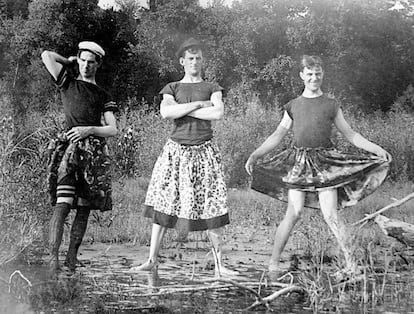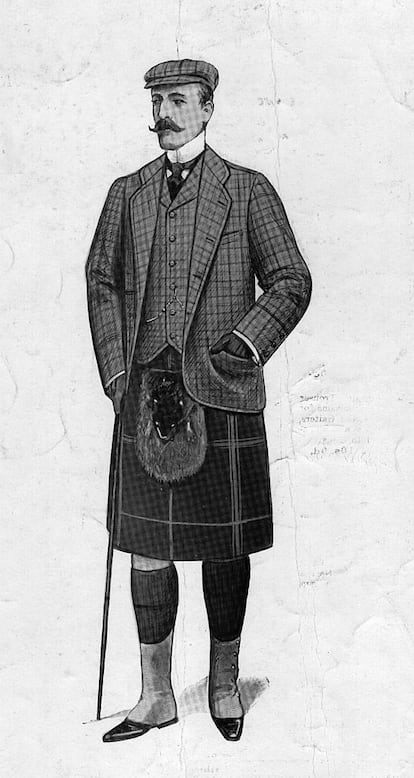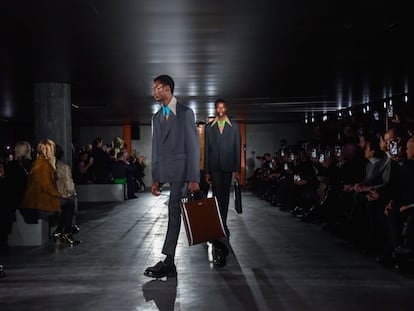Why are men in skirts still stigmatized: A journey to the origins of a misogynistic prejudice
It is no longer surprising to see male designers, actors, pop stars and other pop culture personalities appear in public wearing skirts

A few days ago, at a lunch celebrating the inauguration of an art exhibition, a diner expressed his surprise at finding out that a newly appointed male director of an important Spanish museum often appears in public wearing a skirt. Perhaps interpreting his companions’ muted responses as incredulity, he took out his phone and showed a series of photos in which the director in question appeared in a skirt, an image that anyone who knows him has seen many times. “It bothers me, because it’s not normal,” the offended party explained. The situation reminded me of the recent case of several soccer players photographed at a wedding with designer bags hanging from their shoulders, which incited furious homophobic comments on social media.
At the time, I attributed the reaction to the fact that the world of soccer still harbors remnants of a masculinity based on homophobia and misogyny. The situation I described at the beginning unfolded on much more civilized terms, but I was surprised and disturbed that it occurred in the art world. I realized how naïve I had been, and how necessary it is to question one’s own beliefs.

When in 1984 Jean-Paul Gaultier paraded men in skirts down the runway, it seemed logical to believe that the trend would spread in the coming years. A typical office worker, one could imagine, would go to work each morning wearing a pleated skirt. In an article from that year published in the New York Times, titled “Skirts for men? Yes and no,” the writer cites another French designer, Daniel Hechter, who affirms that it was the most important thing in fashion in 20 years, comparing it to the scandal when women began to wear pants. Gaultier himself emphasized the obvious: “Men and women can wear the same clothes and still be men and women.” Issey Miyake added, “The whole thing came from the streets. My three assistants wear mini skirts.”
Expectations were high. But they were frustrated.
It’s true that it is no longer surprising to see male designers, actors, pop stars and other pop culture personalities appear in public wearing skirts. Ezra Miller, Marc Jacobs, Kanye West and Diddy have all done so.
And gender fluidity has long influenced the fashion world, by the hand of Palomo, Rick Owens, Raf Simons and Vivienne Westwood. There are precedents like David Bowie and Miguel Bosé in the 70s and 80s, or the 1993 story from the magazine Mademoiselle in which the members of Nirvana posed for photographer Stéphane Sednaoui with colorful patterned garments. But after 40 years, none of that has given the skirt a permanent position in men’s wardrobes.
Clothing is charged with cultural connotations. The skirt continues to carry the weight of a Western tradition just a few decades old. The adjective “Western” is important, because other regions include the sarong, izaar, dhoti and hakama, among many others, all of them types of skirts worn by men.
A man in a skirt is not usurping a garment that inherently belongs to women. Images from antiquity show men and women dressed in clothing similar to skirts. Even in societies with distinct gender roles, such as Ancient Greece or imperial Rome, everyone wore different types of tunics, to which Roman citizens added the toga. Today, we would call the outfit a dress. The uniform of Roman legions included a short tunic that peeked out from below the armor in what could be interpreted as a miniskirt. It is said that when the soldiers saw the pants (braccae) that the Gauls wore, they found them suspiciously effeminate. Eventually, though, they adopted them for their incursions into countries with cooler climates.
In that era, France had already positioned itself at the forefront of style. In the Middle Ages, women and men of all extractions wore clothing that took the shape of a skirt, with a shorter version for men. As can be seen in any visit to a museum, in the Early Modern Age, men of the upper classes did not hold back in their attire, sporting glitter, high heels, jewels, bows, lace and wigs, nor were they willing to do without the skirt. In the mid-17th century, a garment called a rhingrave, ruffled skirt-like breeches, swept French and English courts: Louis XIV and Charles II had their portraits painted with it. In the middle of the following century, the climate marked by the Enlightenment brought simpler outfits, and then the Industrial Revolution accelerated the trend.
What the British psychoanalyst John Flügel called the Great Resignation occurred. In practice, it was a double resignation, one chosen and one imposed. The men did away with ornaments, skirts included, and adopted the dark trouser suit uniform, sober and practical, which with minor variations has survived to this day. Meanwhile, the skirt, along with the rest of the arsenal, was left at the exclusive disposal of women to emphasize their role as a decorative object without a voice or vote in the new male-dominated capitalism. To the disabling effect of that skirt, now made up of meters and meters of fabric and armed with structures that gave it excessive volume, was added the corset.
For a long time, women were doubly suffocated: literally by the latter item of clothing, and figuratively by a society that stifled in them any ambition for autonomy.

From then on, the terms “skirt” and “woman” were closely linked in Western societies. “Skirt” became a metonym to refer to women, almost always from a misogynistic perspective: the coda “in a skirt” designates a feminine —and therefore worse— version of masculine achievements. In 1882, the writer Marcelino Menéndez Pelayo referred to the work of his colleague Concepción Arenal as “philosophy in skirts.” In 1914, Ortega y Gasset defined the literary character of Emma Bovary as a “Don Quixote in skirts.” It is ironic that, in this century, Pope Francis called feminism as “machismo with skirts” (an expression that he later retracted), while the church is the only institution where men have continued donning the garment. One of the most remembered songs from the Disney musical Mary Poppins, “Sister Suffragette,” began with the line “We’re clearly soldiers with petticoats” (the petticoat: a skirt under the skirt).
If we are embroiled in a culture war, perhaps a museum director like the one mentioned at the beginning of this article will remain a fierce soldier in skirts, as the suffragettes were more than a century ago. They were branded in their day as radicals —if not lunatics— for demanding something the right to vote for women. Today, a skirt on a male body is still an item of clothing, but because it is out of the ordinary, and challenges nineteenth-century notions about gender, it is also a political statement.

Sign up for our weekly newsletter to get more English-language news coverage from EL PAÍS USA Edition
Tu suscripción se está usando en otro dispositivo
¿Quieres añadir otro usuario a tu suscripción?
Si continúas leyendo en este dispositivo, no se podrá leer en el otro.
FlechaTu suscripción se está usando en otro dispositivo y solo puedes acceder a EL PAÍS desde un dispositivo a la vez.
Si quieres compartir tu cuenta, cambia tu suscripción a la modalidad Premium, así podrás añadir otro usuario. Cada uno accederá con su propia cuenta de email, lo que os permitirá personalizar vuestra experiencia en EL PAÍS.
¿Tienes una suscripción de empresa? Accede aquí para contratar más cuentas.
En el caso de no saber quién está usando tu cuenta, te recomendamos cambiar tu contraseña aquí.
Si decides continuar compartiendo tu cuenta, este mensaje se mostrará en tu dispositivo y en el de la otra persona que está usando tu cuenta de forma indefinida, afectando a tu experiencia de lectura. Puedes consultar aquí los términos y condiciones de la suscripción digital.
More information
Archived In
Últimas noticias
Most viewed
- Sinaloa Cartel war is taking its toll on Los Chapitos
- Oona Chaplin: ‘I told James Cameron that I was living in a treehouse and starting a permaculture project with a friend’
- Reinhard Genzel, Nobel laureate in physics: ‘One-minute videos will never give you the truth’
- Why the price of coffee has skyrocketed: from Brazilian plantations to specialty coffee houses
- Silver prices are going crazy: This is what’s fueling the rally











































